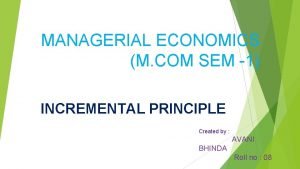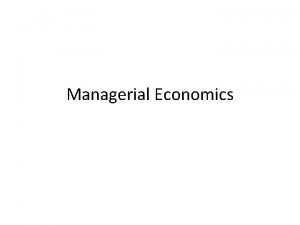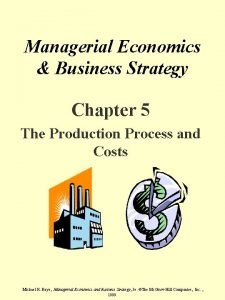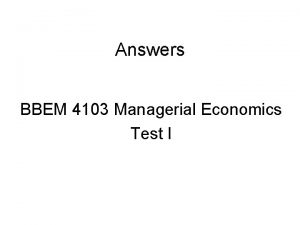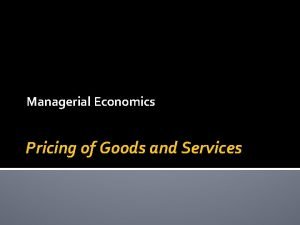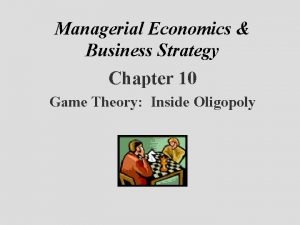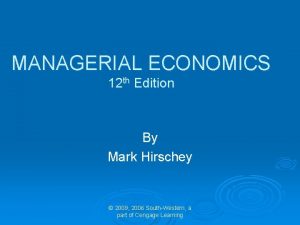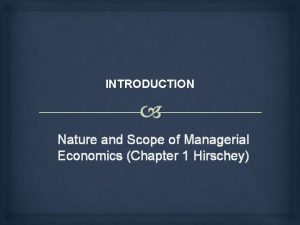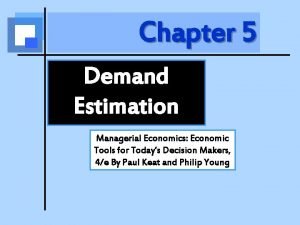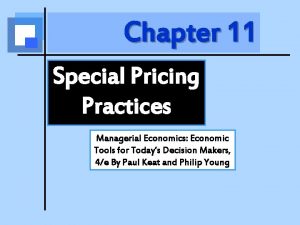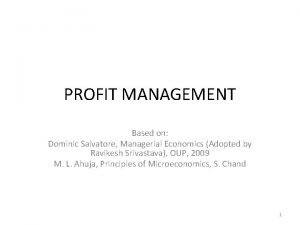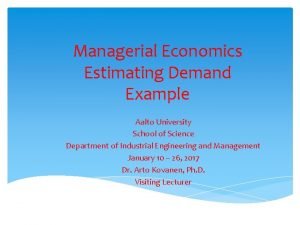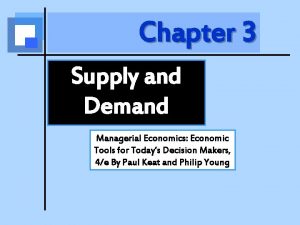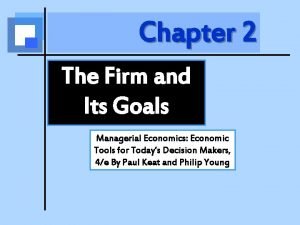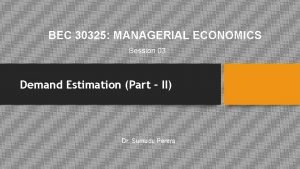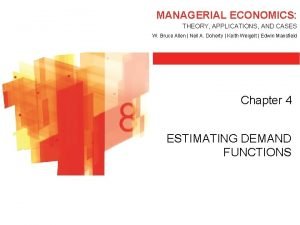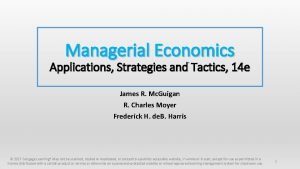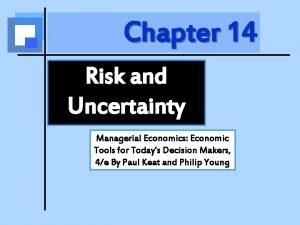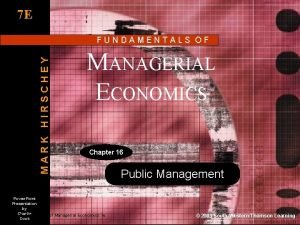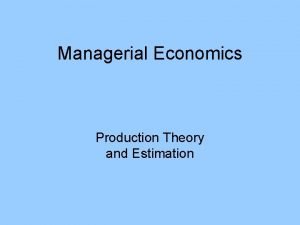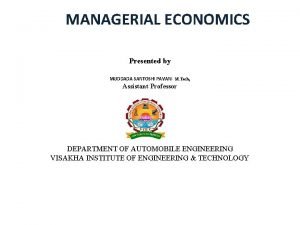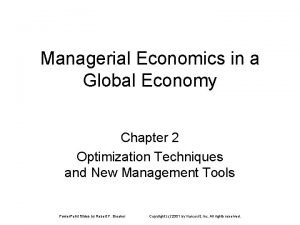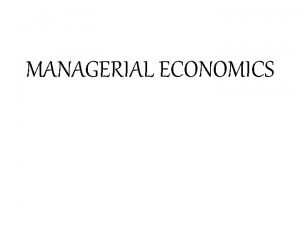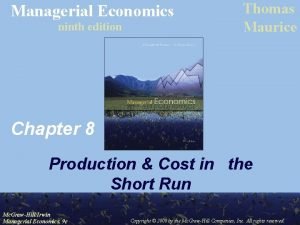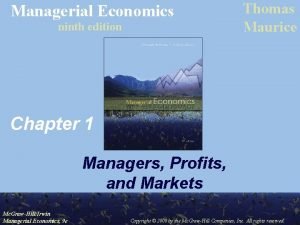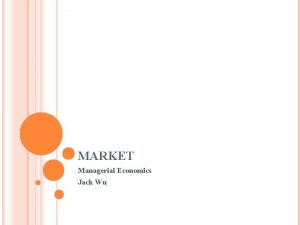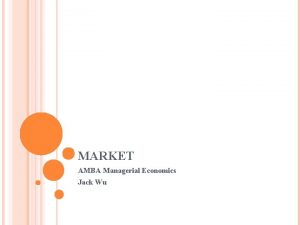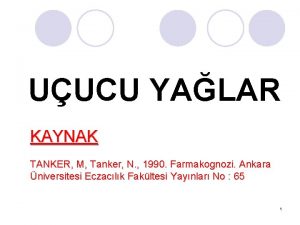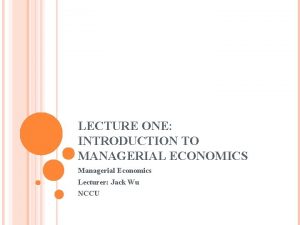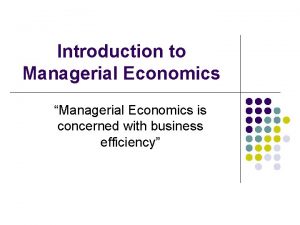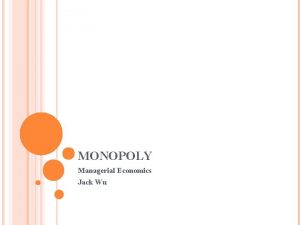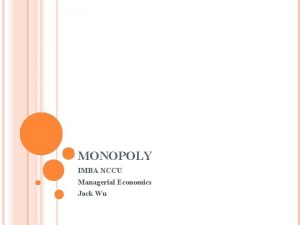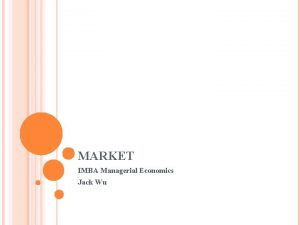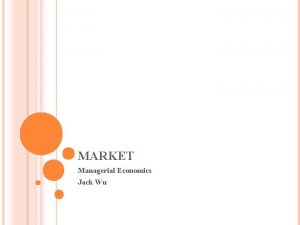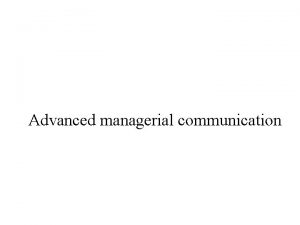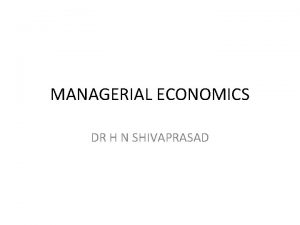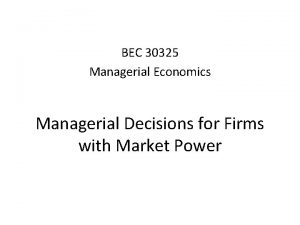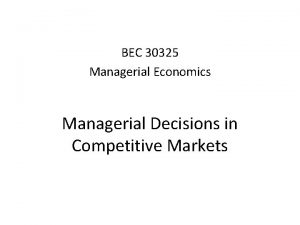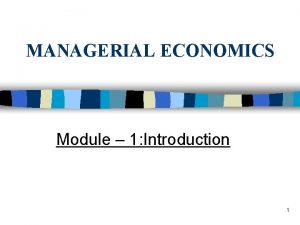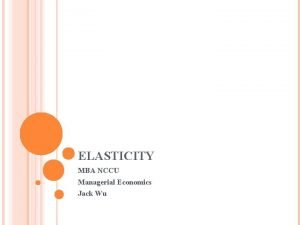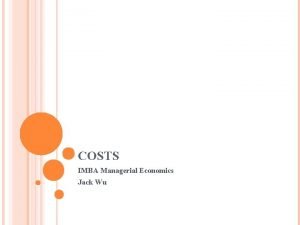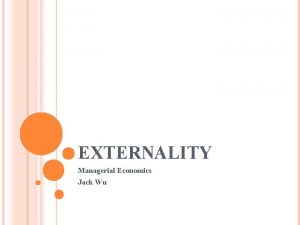MARKET Managerial Economics Jack Wu TANKER SERVICE MARKET

































- Slides: 33

MARKET Managerial Economics Jack Wu

TANKER SERVICE MARKET, 2005 Impact of Increasing oil prices Increasing China imports More stringent tanker standards

PERFECTLY COMPETITIVE MARKET homogeneous (identical) product many small buyers many small sellers price takers (No influence on price) free entry and exit (No barriers) Both buyers and sellers share equal (symmetric) information

DIFFERENTIATED OR HOMOGENEOUS In market where products are differentiated, competition is not as keen as that in a market where products are homogeneous. Compare mineral water – differentiated gold – pure commodity

NO MARKET POWER Many small buyers Many small sellers Both buyers and sellers have no market powers. Both buyers and sellers are price takers. Note: buyer/seller with market power can influence market conditions

NO BARRIERS Free entry and exit No entry barriers to potential competitors No exit barriers to existing sellers

FREE ENTRY? Japanese Beer Market, pre-’ 94: Ministry of Finance production licenses for minimum of 2 million liters a year sales licenses limited to small family-owned stores

SYMMETRIC OR ASYMMETRIC INFORMATION Market with differences in information not as competitive as one where all buyers and sellers have equal information Compare photocopying service medical treatment legal advice

MARKET EQUILIBRIUM, I Price at which quantity demanded equals quantity supplied when market out of equilibrium, market forces push price towards equilibrium

Price ($ per ton-mile) MARKET EQUILIBRIUM, II a excess supply 22 b 20 equilibrium c 0 demand 8 10 11 Quantity (Million ton-miles a year)

MARKET EQUILIBRIUM, III excess supply = excess of quantity supplied over quantity demanded triggers price decrease excess demand = excess of qty demanded over qty supplied triggers price increase

SUPPLY SHIFT, I supply shifts down (right) -> lower price, larger quantity supply shifts up (left) -> higher price, smaller quantity final equilibrium depends on elasticities of demand supply

Price ($ per ton-mile) SUPPLY SHIFT, II a original supply b 20 19. 60 60 cents new supply d c 0 demand 60 cents e 10 10. 4 Quantity (Million ton-miles a year)

PRICE ELASTICITIES OF DEMAND Extremely inelastic demand Extremely elastic demand original supply b 20 new supply 19. 40 c 0 60 cents e 60 cents 10 Quantity (Million ton-miles a year) Price ($ per ton-mile) demand original supply 20 b c 0 e 60 cents new supply demand 60 cents 10 10. 6 Quantity (Million ton-miles a year)

PRICE ELASTICITIES OF SUPPLY a original and new supply 20 b demand 0 Extremely elastic supply 10 Quantity (Million ton-miles a year) Price ($ per ton-mile) Extremely inelastic supply a 20 19. 40 60 cents original supply 60 cents new supply b demand 0 10 11 Quantity (Million ton-miles a year)

SUPPLY SHIFT: PRICE IMPACT price change no more than amount of the supply shift price change smaller if demand is more elastic than supply larger if supply is more elastic than demand

Price ($ per unit) PROMOTING RETAIL SALES retail supply 1. 50 after wholesale price cut a b retail demand 0 1 Q Quantity (Million units a year)

DEMAND SHIFT, I demand shifts down (left) -> lower price, lower quantity demand shifts up (right) -> higher price, larger quantity final equilibrium depends on elasticities of demand supply

Price ($ per ton-mile) DEMAND SHIFT, II supply a 1 million f b 20 new demand 1 million original demand c 0 10 10. 8 Quantity (Million ton-miles a year)

TANKER SERVICES, 2005 Increasing oil prices Higher Increasing China imports Higher costs for tanker services supply curve up demand for tanker services More stringent tanker standards Non-complying to left tankers scrapped supply curve shifted

VALENTINE’S DAY Nearing Valentine’s Day, price of roses always rises much more than the price of greeting cards. Why?

CALCULATING EQUILIBRIUM, I How would 3% increase in income affect price and sales of gasoline? demand price elasticity -. 23 income elasticity 0. 39 supply price elasticity 0. 62

CALCULATING EQUILIBRIUM, II 1. 2. 3. 4. % change in qty demanded = -0. 23 %p + 0. 39 x 3 % change in qty supplied = 0. 62 %p equate and solve: %p = 1. 38% % change in qty = 0. 87%

SHORT-RUN MARKET EQUILIBRIUM short-run marginal cost short-run average variable cost 22 20 0 price 100 105 Quantity (Thousand ton-miles a year) (b) Market Price ($ per ton-mile) Price ($per ton-mile) (a) Individual seller short-run supply 1 million c 22 20 0 a short-run demand 10 12 Quantity (Thousand ton-miles a year)

LONG-RUN MARKET EQUILIBRIUM long-run marginal cost 21 20 0 new long-run average cost original longrun average cost 100 Quantity (Thousand ton-miles a year) (b) Market Price ($ per ton-mile) Price ($per ton-mile) (a) Individual seller long-run supply 1 million d 21 20 0 a long-run demand 10 13 Quantity (Thousand ton-miles a year)

SHORT/LONG-RUN IMPACT If demand/supply shifts, market price is more volatile in the short run than long run greater change in market quantity over the long run than short run

DEMAND INCREASE

DEMAND REDUCTION

PRICING AND FREIGHT COST, I cost and freight ex-works pricing How sales? does pricing policy affect

Price ($ per pound) PRICING AND FREIGHT COST, II CF supply 25 cents 1. 50 a ex-works supply b CF demand ex-works demand 0 1 Quantity (Million pounds a year)

RETAILING: WHY COUPONS? alternative -- cutting wholesale prices “With coupons, prevent retailers from getting part of price cut. ”

DISCUSSION QUESTION Industry researchers R. S. Platou predicted that, between 2003 and 2004, oil prices would fall by 5%, production of oil by OPEC and the former Soviet Union would increase, and deliveries of new tankers would exceed scrappage of older vessels.

DISCUSSION QUESTION (a)Uisng suitable diagrams, explain how each of the following would affect the market for tanker services: (i) fall in oil prices; (ii) increase in production by OPEC and the former Soviet Union; (iii) new tanker deliveries; and (iv) scrappage of older vessels. (b)Suppose that the net effect is to increase tanker rates. Illustrate the net effect on a single diagram. Explain the impact on the quantity of tanker services used.
 Describe jack from jack and the beanstalk
Describe jack from jack and the beanstalk Meaning of managerial economic
Meaning of managerial economic Incremental principle in managerial economics
Incremental principle in managerial economics Managerial economics
Managerial economics Methods of demand forecasting in managerial economics
Methods of demand forecasting in managerial economics Nature and scope of managerial economics
Nature and scope of managerial economics Ecomics
Ecomics Managerial economics define
Managerial economics define Methods of cost estimation in managerial economics
Methods of cost estimation in managerial economics Fundamental concepts of business economics
Fundamental concepts of business economics Managerial economics questions and answers
Managerial economics questions and answers Pricing methods in managerial economics
Pricing methods in managerial economics Game theory managerial economics
Game theory managerial economics Managerial economics hirschey
Managerial economics hirschey Fundamental concepts of managerial economics
Fundamental concepts of managerial economics Nature and scope of managerial economics
Nature and scope of managerial economics How managerial economics is useful to engineers
How managerial economics is useful to engineers Regression analysis in managerial economics
Regression analysis in managerial economics Transfer pricing in managerial economics
Transfer pricing in managerial economics Profit management in managerial economics
Profit management in managerial economics Example of managerial economics
Example of managerial economics Demand and supply analysis in managerial economics
Demand and supply analysis in managerial economics Goals of a firm in managerial economics
Goals of a firm in managerial economics Demand estimation in managerial economics
Demand estimation in managerial economics Managerial economics: theory, applications, and cases
Managerial economics: theory, applications, and cases Managerial economics applications strategy and tactics
Managerial economics applications strategy and tactics Risk and uncertainty in managerial economics
Risk and uncertainty in managerial economics Fundamentals of managerial economics mark hirschey
Fundamentals of managerial economics mark hirschey Production theory and estimation
Production theory and estimation Managerial economics
Managerial economics Managerial economics is called as
Managerial economics is called as Managerial economics
Managerial economics Managerial economics
Managerial economics Managerial economics
Managerial economics


